

How Do Tennis Rankings Work? (Easy Guide)
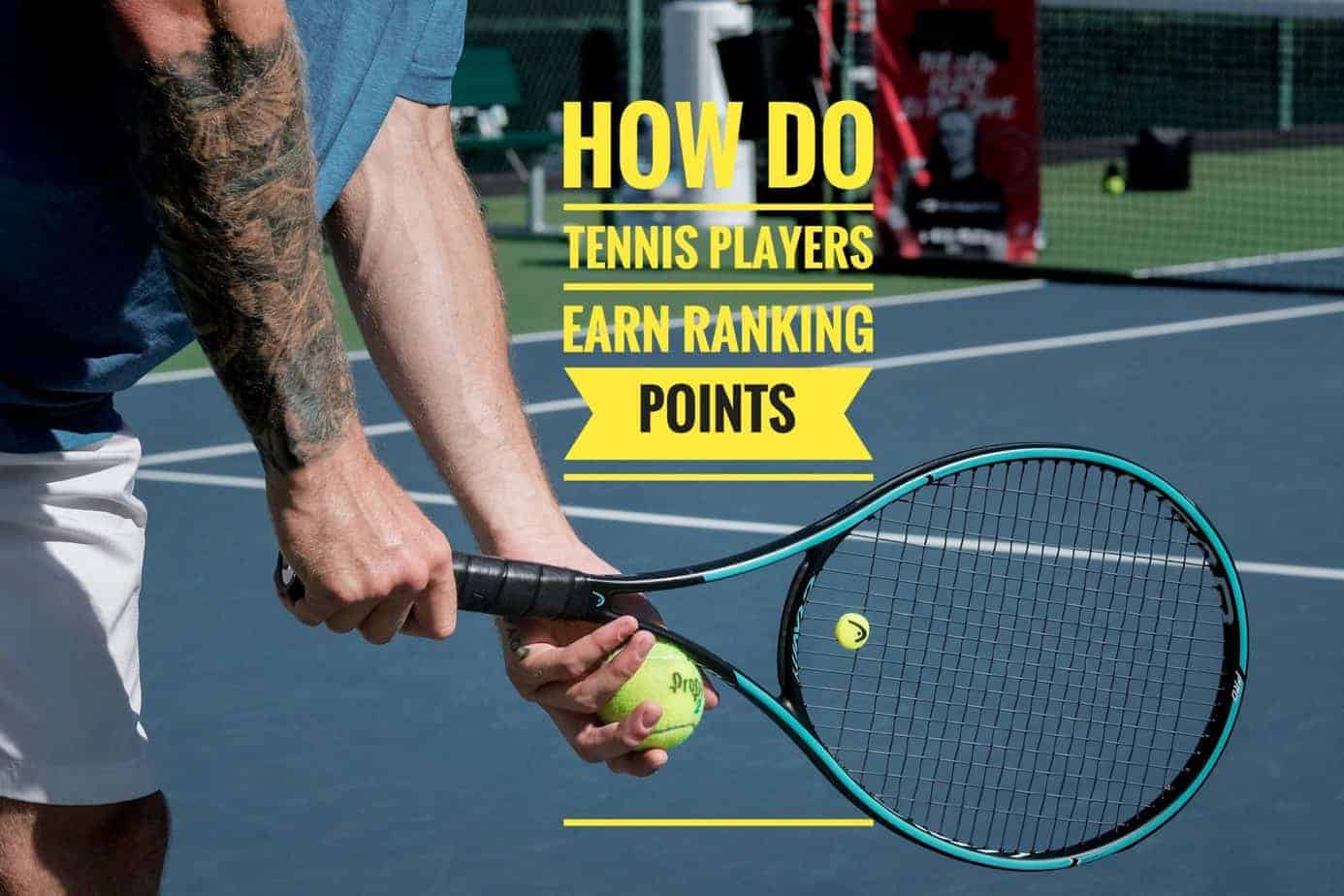
When you are a professional tennis player, you often get asked “how do you become a professional tennis player?”. Because tennis is an individual sport, players do not get hired by a team or club (like the NBA, NFL, NHL, Soccer/Football Clubs, etc) so it can be quite difficult to understand the path players need to take in order to reach the top of the rankings.
Tennis rankings work based on a points system that adds up players’ 18 best results in the previous 52 weeks. In order to earn ranking points, tennis players must participate in events hosted by the International Tennis Federation (ITF), the ATP, and the WTA. The number of points earned by the player depends on the round the player loses.
The ITF hosts the Grand Slams and the ITF World Tour Circuit for both men and women. The ATP is in charge of the men’s ATP Tour and Challenger Tour and the WTA takes the lead on the women’s side, putting together the WTA Premier Mandatory, WTA Premier 5, WTA Premier, WTA International and WTA 125K events. Each one of these events has a different point distribution system.
ATP Ranking (Men’s Tour)
The ATP rankings list is the gold standard when it comes to men’s tennis. “The ATP is the governing body of the men’s professional tennis circuits – the ATP Tour and the ATP Challenger Tour. The ATP determines the rules for ATP tournaments and determines the points allocation for all men’s professional events ” (ITF World Tennis Tour).
A professional tennis player’s ability to enter tournaments is determined by their position in the rankings. The higher a player’s ranking is (closer to #1), the better. If a player is ranked #70 in the world, wins a tournament, and moves to #40, that player is considered to have moved up in the rankings.
A player’s ranking is determined by their performance in Grand Slams, ATP Tour and Challenger Tournaments, 25K ITF tournaments, and 15K ITF Tournaments. The player’s ranking is based on their best 16 results during a calendar year. The points for a tournament will count towards a player’s ranking for a total of 52 weeks following the result.The ATP Points allocation table is as follows:
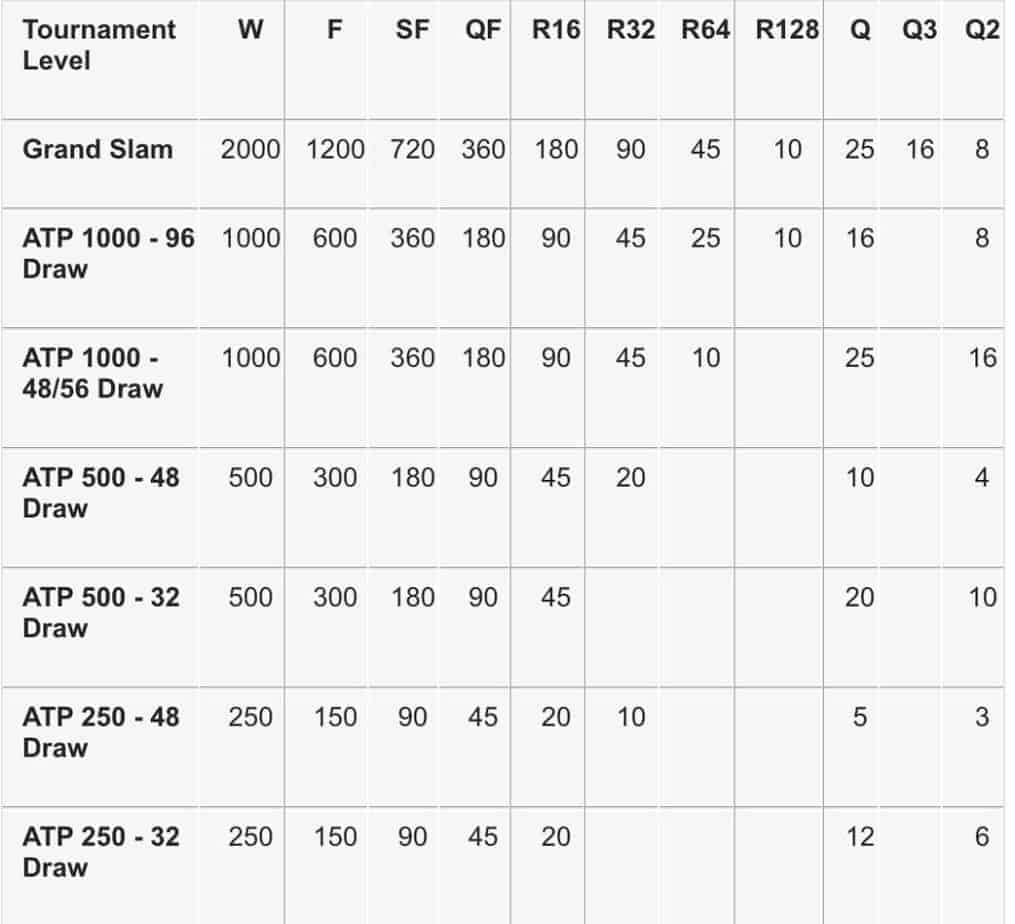
ITF $15,000 and $25,000 (Men)
The first step on the journey of becoming a professional tennis player is to play ITF 15Ks and 25Ks, which are called “futures events.” Futures are where players can earn their first ATP points and get their names on the rankings.
Futures are small events with a total purse of either 15K or 25K distributed among all the players, which includes both singles and doubles. In order to enter these events, players need an IPIN account (a service by ITF), which costs $65 dollars a year. Anyone can have an IPIN account, even without ATP points, and it is on this platform where players sign up for tournaments.
The first (of many) challenging part of playing professionally is being able to play futures events without having ATP points.
When players sign up for futures, the acceptance list is based on the ATP Ranking. There are 20 main draw spots and 48 qualifying spots . If players do not have ATP points, they will often find themselves deep on the alternates page on the acceptance list.
Alternates are the players waiting to get into qualifying. In futures, the players in the qualifying and alternate lists need to sign in to the tournament on-site the day before the qualifying starts.
The problem when players are starting to play futures (and have no ranking) is that there are often many players in front of them on the list, which can be deflating. It is hard to justify traveling to a tournament without knowing for a fact if that player will be able to compete.
That is not to say the qualifying draw will always fill up and you won’t be able to play. In fact, most lower-level tournaments do end up having multiple spots not filled in the qualifying after sign-in. Regardless, starting your professional career can feel overwhelming from the get-go. Some people can rely on wild cards but that is a luxury most players do not have. In any case, here is the points break-down for futures:

Earning that first ATP point is super important. Not only is it a great personal achievement, but it means a player will often be able to compete in any futures qualifying draw. While not many people bat an eye at futures events, they are a major character-building time in a player’s career.
The majority of the players are not able to level up to challengers, therefore most pro careers die here. Now let’s move on to the next level, the ATP Challenger Tour.
ATP Challenger Tour:
After you earn enough points at playing futures, you can graduate to the ATP Challenger Tour. The Challengers are the lowest level tournaments hosted by the ATP. There are 5 tiers of challengers: ATP Challenger Tour 80, 90, 100, 110 and 125. Here is the points breakdown:

As you can see, there is a huge jump in points awarded per round won from futures to challengers. That translates into much tougher competition. Players whose rankings are high enough to be directly accepted will most often compete at a challenger because there is more money and points to be earned.
Cutoffs have changed a bit this year because the draw size at Challenger events increased from 32 to 48 players. Regardless, the cutoff will largely depend on the availability of other tournaments at any given week. Weeks that only have one or two challengers will have cutoffs in the three hundreds, where weeks where there are 4 plus challengers will see the cutoffs dropping to the five, six hundreds.
The challenger level is where we see a lot of the current stars break through. It is where the great get separated from the good. If you ever have the chance to go watch a challenger, do it. Entrance will most likely be free and you will watch high quality tennis all around. Most challenger events include one, if not a couple of current top 100 players.
ATP Tour Events
Aside from Grand Slams, the ATP Tour events are the most well known tournaments. As a player, the ATP Tour is where you want to be. The tournaments are bigger, there is more money and points involved and the atmosphere is awesome. The ATP Tour is the NBA of the tennis world. To consistently play ATP Tour events, a player will have to be ranked inside the top 100. There are three tiers of ATP tour events: ATP Tour 250, ATP Tour 500 and ATP Tour Masters 1000.
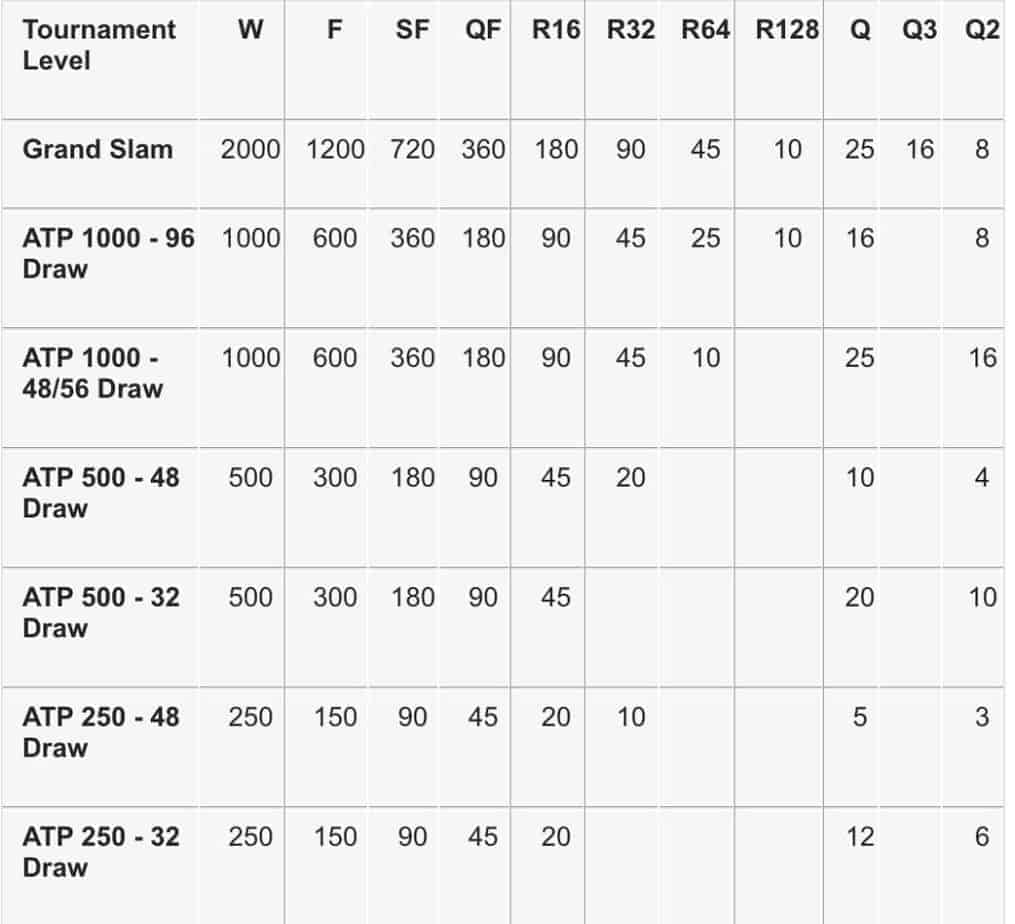
Again, you can see the point distribution drastically increases from the Challenger Tour to the ATP Tour. Players competing on the ATP Tour are the best of the best, and it is every tennis player’s dream to be able to compete on the ATP Tour throughout their careers. The only events that are bigger are the Grand Slams.
Grand Slams
The Grand Slams are the holy grail of tennis. They are the most prestigious events of the year and this is where the most points are awarded. There are four grand slams: Australian Open, Roland Garros (French Open), Wimbledon and the US Open. Here is the points breakdown:

As you should notice, there are massive amounts of points that can be gained at grand slam events. For a player to become number one, he/she will most likely have to win a Grand Slam. If not, the players will have to be incredibly consistent outside of Grand slams. Very few players have achieved that.
WTA Tour (Women’s)
The WTA journey is, for the most part, similar to the ATP. The Women’s Tennis Association is the governing body of the women’s professional tennis circuits. It determines the points allocation for all events. Here is the WTA Points Table.
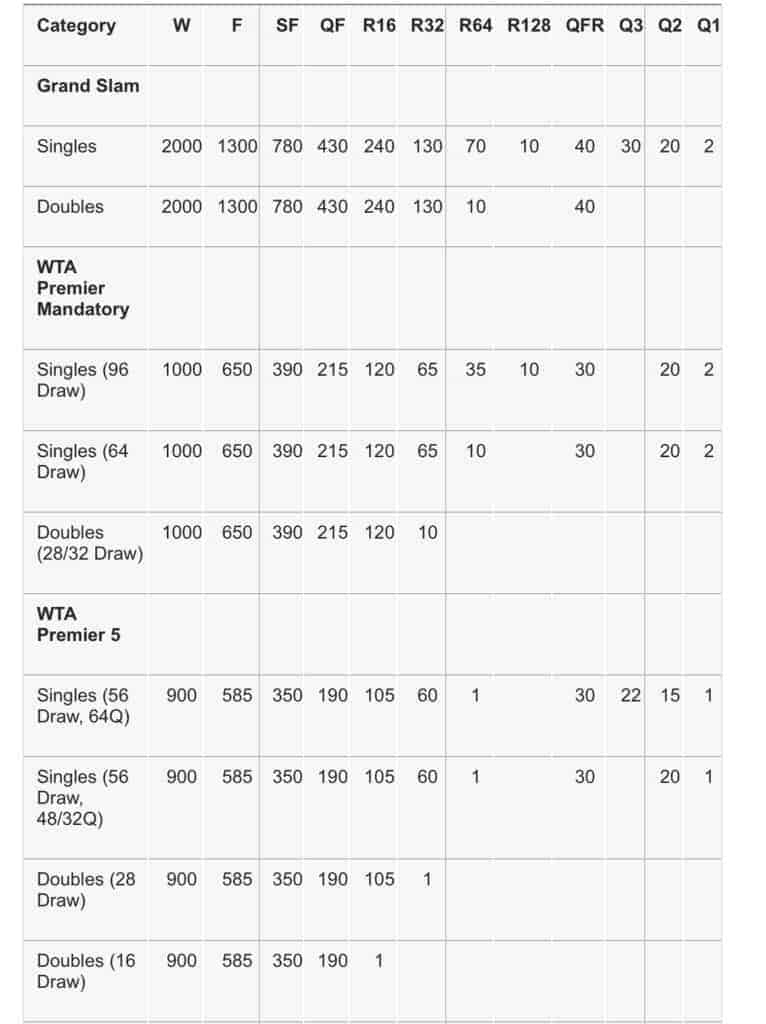
“A player’s ranking for singles is based off their best 16 tournaments and best 11 tournaments for doubles. To have a WTA ranking, players must have WTA ranking points from 3 tournaments or a total of 10 WTA ranking points” – ITF World Tour Points website.
As you can see, there are a few differences in the point structure between the ATP and the WTA. On the women’s side, you need to earn points in three different events in order to be on the WTA rankings, where on the men’s side as long as you win one main draw future’s match, you will automatically be in the rankings.
How Many Points Players Need to Move Up Level
Now that you know how players earn ranking points, let’s take a look at how many points player’s need to earn in order to move up the rankings.
As you can see, the higher a player’s ranking is, the more points you need earn per tournament in order to continue the upwards trajectory in the rankings. During the future’s stage, it is easier to make big jumps up the rankings. As you move higher, the more difficult it is to do so.
Consistency is key and at the end of the day, there is no magic recipe; the more matches you win the higher your ranking will be. Outsiders usually do not understand how long the journey to top 100 is. It is quite literally a marathon and the majority of players won’t make it through the finish line. Most of the players who reach the top 100 do so after years on tour.
I’ve had some pretty cool experiences during my tennis career. I’ve reached the semifinals of the Orange Bowl U16 and as a junior, I ranked as high as #33 in the world. I have had wins over Dominic Thiem, Kyle Edmund, and Hugo Dellien (not sure how well I would do against them today, though). One of the coolest things I’ve done while playing was reaching the finals of the NCAA’s with UCLA, so I’m a great supporter of college tennis. I’ve won 3 futures since graduating, and I broke the top 400 on the ATP rankings. And most importantly, I have been to Pete Sampras’ house.
Recent Posts
The Best Babolat Tennis Rackets (for Every Type of Player)
Babolat have been producing tennis equipment since 1875, and today they manufacture a range of rackets that offers something for everyone. Whether you are on a tight budget, or money is no object,...
The Top 3 Best Babolat Tennis Rackets Under $100
If you are a beginner or recreational player, or a junior just considering your first full-sized racket, you will be pleased to know that Babolat offer a range aimed squarely at you. Without some of...
ATP and WTA Points and Rankings Explained
Players and fans follow ATP and WTA rankings. It basically shows how good the player is (in comparison with others). The system of how the ATP and WTA points are counted is easy, but not everyone knows the logic behind it. Therefore, we prepared a quick cheat sheet to get basic knowledge about points and ATP/WTA rankings.

ATP 250 & WTA 500 Prize Money & Points
ATP Tournament Schedule – WTA Tournament Schedule
Use of Rankings
The number one player in the ranking is referred to as the world’s best tennis player.
Moreover, the official ATP and WTA rankings are used to determine entry and seeding in all tournaments (except ATP and WTA Finals).
ATP Ranking points system
There are four categories of ATP tour tournaments [Grand Slams*, ATP 1000, ATP 500, ATP 250] and six categories of lower-tier ATP Challenger tournaments [125, 110, 100, 90, 80, 50].
The number in the category name indicates the number of points awarded to the winner of the tournament.
*Grand Slams are officially organized by ITF (International Tennis Federation), but the points are included in ATP Tour rankings.
ATP Points table
- points are awarded according to tournament category and number of players in the singles draw
- the number of rounds depends on the number of players in the singles draw
- points are awarded to the loser in the respective round
Source: ATP Official Rulebook
Up-to-date ATP & WTA Rankings: ATP TOP 10 – ATP TOP 100
WTA Ranking points system
WTA adopted the new system of categories at the start of the 2021 season. It adopts a similar system to the one used by the ATP tour.
There are four categories of WTA tournaments [Grand Slams*, WTA 1000, WTA 500, WTA 250] and one lower-tier WTA 125 tournament. WTA tournaments are further divided into mandatory and non-mandatory categories.
However, the number in the category name indicates the value of the tournament. Still, it is not always equal to the points awarded to the winner of the tournament (that is the difference from ATP).
*Grand Slams are officially organized by ITF (International Tennis Federation), but the points are included in WTA Tour rankings.
WTA Points table
Source: WTA official rulebook
Up-to-date ATP & WTA Rankings: WTA TOP 10 – WTA TOP 100
The time period for official ranking purposes
Official rankings take into account the points earned by players in the last fifty-two weeks (which was increased to the best of the “2019 – 2020” model temporarily in 2020 due to a “covid” break).
It means that ATP/WTA ranking shows how many points players gained in tournaments in the last fifty-two weeks. The rankings are published every Monday.
Due to players’ mandatory obligation to participate in various tournaments, the rankings are calculated from the last 19 tournaments played by men and the last 16 tournaments played by ladies, but the fifty-two-week time frame applies.
That means that if you play in the last 52 weeks less than 19 (or 16) tournaments, just the results from the tournaments you played are counted.
ATP & WTA Finals rankings
Except for the official ranking, ATP and WTA also calculate the ranking for their ATP and WTA finals qualification purposes.
It is called “Race to Turin” in ATP and “Porsche Race to Shenzen” in WTA (both organizations using the names of host cities of finals in respective years).
These rankings are different from the official continuous ATP and WTA rankings.
In these rankings, just points gained in the respective season are calculated. The “Race to …” rankings are closed when the last tournament before the finals is finished. The first seven players of these rankings qualify for the season ATP/WTA finals. The eighth player for the final is either the grand slam winner who is between 8th and 20th place in the ranking or the eight-player of the ranking.
Share this:
Tennis Pro Guru
Simon is the leading editor of TennisProGuru.com from 2015. He is an avid tennis player from age of 5, however, he never reached the pro level. Still, he likes playing tennis on different courts, with different rackets, and against different opponents. In his free time, you can find him watching all possible tennis matches he can find on the web or tv. Challenger or Grand Slam? It does not matter, just tennis matters.
He currently plays with: Racket: Wilson Shift 99 V1 Strings: Babolat RPM Blast Grip: Head Xtreme Soft Shoes: Asics Gel Dedicate 7 (for hard outdoor and indoor courts) & Asics Gel-Game 5 Clay (for clay courts) , Balls: Dunlop Fort All Courts and Head Championship Bag: Axiom Backpack
Leave a Reply Cancel reply
Your email address will not be published. Required fields are marked *
Notify me of follow-up comments by email.

The ATP Challenger Tour: Path to the Big Time
- Last updated on May 2, 2023
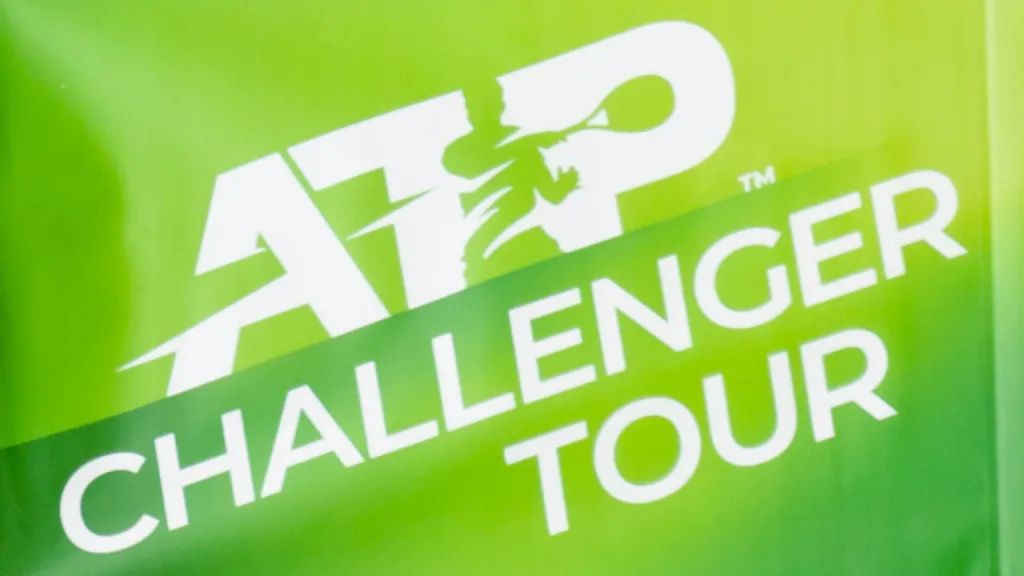
Established in 1978, the Challenger circuit has grown into an important stepping stone for young tennis players looking to make it to the highest levels of the sport.
History of the Challenger Tour
The Challenger circuit was established as a way to provide a professional level of competition for tennis players who weren’t yet ready to compete on the main tour. The circuit initially consisted of just five tournaments in the United States, but quickly grew in popularity and spread around the world.
By the mid-1980s, the Challengers had become an important part of the tennis landscape, with dozens of tournaments held each year. In 1986, the ATP officially recognized the circuit and began awarding ranking points to players based on their performances.
Since then, the circuit has continued to grow in popularity and importance, with the number of tournaments held annually growing steadily year by year. In 2008 there were 178 events played across 40 different countries.
And although numbers have occasionally diminished, for example in the first quarter of 2013 and an inevitable dip due to Covid-19, they’ve since bounced back with 184 events taking place in 2022 and a record 190 plus planned for 2023.
Format of the Challenger Circuit
Challenger tournaments are generally smaller than those on the ATP World Tour, with most events featuring a draw of 32 or 64 players.
The format of the tournaments is similar to that of other professional tennis events, with players competing in singles and doubles matches. The matches are generally played over three sets, although some tournaments may have different rules depending on the surface and location of the event.
The winner of a Challenger event typically earns around 80 ranking points and a prize purse of between $50,000 and $125,000. By contrast, the winner of an ATP Tour event can earn upwards of 1,000 ranking points and a prize purse of more than $1 million.
However in 2023 the ATP launched a new tier of Challengers known as Challenger 175s in which, as the name suggests, the winner can earn 175 points along with prize money of $220,000.
Importance of the ATP Challenger Circuit
For young, ambitious players, the Challenger circuit is vital. It provides an opportunity to gain valuable experience playing against other pros, while also earning vital ranking points and prize money.
Many of the world’s top players have competed in Challenger events at some point in their careers. Rafael Nadal, Novak Djokovic, and Andy Murray all spent time on the Challenger circuit before making it to the main tour. In fact, Nadal won his first professional title at a Challenger event in 2002, Djokovic in 2004.
The circuit is also an important way for players to gain exposure and build their profiles in the tennis world. While it may not have the same level of media coverage as the ATP Tour, it provides a platform for players to showcase their talents and gain recognition from fans and sponsors.
In addition to helping young players make their way up the rankings, the Challenger circuit also plays an important role in the overall development of the sport. By providing a professional level of competition for players who are not yet ready for the ATP Tour, the circuit helps to ensure a strong pipeline of talent coming up through the ranks.
Challenger Challenges
Despite its importance, the circuit faces numerous challenges in the modern era. One of the biggest is the high cost of hosting events, which can run up to $200,000 when accounting for prize money, player accommodations, and other expenses. With smaller prize pools and less visibility than ATP Tour events, hosting organizations may struggle to justify the expense of hosting a Challenger tournament.
Another issue is the emergence of alternative tours and circuits, such as the ITF World Tennis Tour and the PTPA Challenger-style circuit. These tours provide players with additional options for competing at the professional level, which may lead some players to prioritize these events over Challenger tournaments.
The Challenger Circuit has been criticized for being financially unsustainable for players who are not in the top 100. The prize money on offer at Challenger tournaments is significantly less than that on the ATP Tour, and the costs associated with travelling to tournaments and paying for accommodation can make it difficult for players to make a living on the Challenger Circuit.
Rising to the Challenge
If you get the opportunity, the Challenger circuit is a great way to get to see up and coming stars before they hit the big time – and the occasional wizened pro. Keep an eye out right here for info on individual tournaments and if you’re looking to start your own path to the Challengers check out our round up of the best tennis rackets for beginners .
Recent Posts:
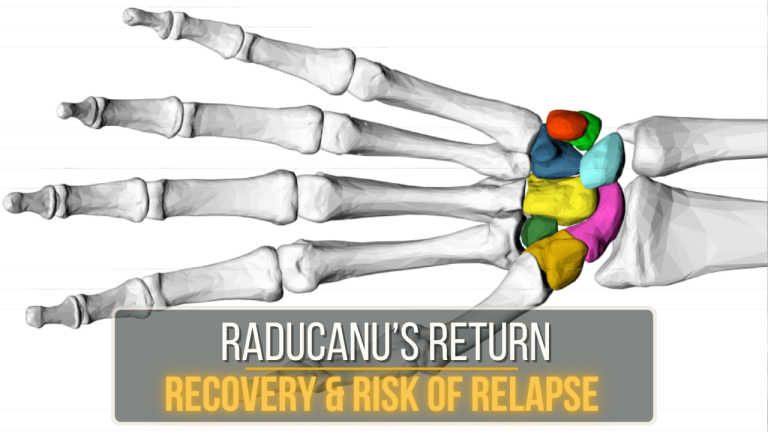
- Members Login
- tennis tips
- prize money in tennis atp wta challenger insights 2023
Prize Money In Tennis: ATP, WTA & Challenger Insights 2024
So, you want to know about prize money in tennis? You are wondering how much elite players earn, and are curious about life as a professional. Is it a life of privilege for all, earning millions while playing the game we love? Well, wonder no more, the Bros have you covered with our detailed breakdown.
Our analysis will almost certainly make you envious, but it may surprise you for very different reasons too. Prize money in tennis varies wildly. From grand slam winning, multi-millionaires, to journeymen and fledgling pros, life on tour can mean very different things depending on your level.
Custom Fittings
Discover your perfect racket and string combo!
Disclosure: Our website contains affiliate links, which means we may earn a commission if you purchase through these links. This comes at no additional cost to you and helps support our efforts in providing valuable information about tennis equipment.
Rest assured, we only recommend products we believe will benefit our readers and enhance their tennis experience. Your support is greatly appreciated!
Tennis Prize Money at the Different Levels of the Game
The big names and the biggest stages on which they play are familiar to us all. And thanks to social media we have a window into their world beyond the court. Private jets, lucrative brand deals, and A-list friends are commonplace, but this is not real life for tennis players at every level.
For the majority of players, life on tour is tough. Prize money seldom covers a player’s expenses and it may come as a surprise just how little some professionals earn. Here we explore each level of the professional game and assess what prize money is on offer.
Prize Money on the ITF Tours
Life in the paid ranks starts with the ITF Futures Tour for men and for female players, the ITF Women’s Tour. This level is the foundation from which many of today’s superstars have graduated.
It is home for many new professionals and elite juniors allowing them to earn official ranking ATP points as they begin their quest to join the higher echelons.
Prize money at this level is very modest with both men and ladies competing for tournament funds totaling between $15,000 and $25,000.
Winners take home anything between $2000 and $4000 while first-round losers earn a meager cheque relative to the expense associated with travel, accommodation, and all sundry costs. Expenses that can often include equipment with many players having no brand deals at this level. Consequently, early-round losses for ITF Futures players can often result in a net loss for that week.
And if you want a real-life example of how tough things are for players at this level, we dive into this – later in this article.
The ITF World Tennis Tour, formerly known as the ITF Futures Tour, doesn’t have multiple prize money tiers like the ATP Challenger Tour. ITF World Tennis Tour events are split into different tournament categories based on a set amount of prize money offered. In 2024, these categories are:
- Men’s: M15 ($15,000) and M25 ($25,000)
- Women’s: W15 ($15,000), W25 ($25,000), W50 ($50,000), W75 ($75,000) and W100 ($100,000)
It’s important to remember that this is the total prize money for the entire tournament, which is then divided among the players based on their performance in the singles and doubles competitions.
Winners will receive the biggest chunk of the prize money, while losers will receive much less. The ITF doesn’t disclose specific breakdowns for how prize money is distributed amongst winners and losers.
Prize Money on the Challenger Tours
The next level for professional players is the ATP Challenger Tour and WTA Challenger Series for men and ladies respectively. Here the prize money increases significantly. But again, players are battling for prize pots that are a fraction of what is made available to the game’s elite.
In 2021, ATP Challenger Tour players competed for prize money ranging from $36,680 to $156,240 per tournament, whereas their WTA counterparts contested similar purses. For tournament winners, on average, this equated to a payday of around $21,000 to go with the winner’s trophy.
Things will change dramatically in 2023 however. A huge cash injection being made by the ATP Tour is set to elevate prize money by 60% for Challenger Tour players.
The ATP recently announced an increase in total prize money for the 2023 season which sees their total commitment reach $21.1m over 195 tournaments. Furthermore, they have simplified the tournament ranking system.
You may hear of tournaments being classified as ATP 125 or ATP 150 and have wondered if that has something to do with prize money. Well, it refers to ranking points. The winner of an ATP 125 event garners 125 ATP ranking points. Naturally, prize money tends to increase in correlation with the ranking points on offer.
The availability of more ranking points attracts better players, better players mean bigger audiences. Therefore the caliber of sponsors improves and so the tournament coffers grow. Thus, we generally see a direct correlation between ranking points and the prize money on offer.
And along with increasing prize money, the ATP Tour will also revamp its ranking point classifications for Challenger Tour level tennis. In 2023 players will compete in ATP 50, ATP 75, and ATP 100 tournaments with some of the more obscure classifications (ATP 90, ATP 110) now defunct.
Finally, 2023 also sees the introduction of three ‘premium’ ATP Challenger Tour events. Players will not only play for 175 ranking points but will also duel over a $220,000 prize fund per tournament – unprecedented at this level.
Clearly (and by their own admission), the ATP Tour comprehends the importance of tennis at this level and its responsibility to help incubate future superstars. With increased financial commitment the tour is attempting to attract burgeoning talent, making it a more desirable and watchable pursuit.
The prize money on the ATP Challenger Tour in 2024 varies depending on the tournament. The ATP sets a minimum prize pool of $41,000 (or €36,900) for Challenger Tour events, but some tournaments offer significantly more. The highest tier of Challenger events, Challenger 175, offers a total prize pool of $220,000 (or €200,000) or more.
Here’s a breakdown of the prize money tiers for Challenger Tour events in 2024:
Challenger 175: $220,000+ (or €200,000+) Challenger 125: $160,000+ (or €145,000+) Challenger 100: $130,000+ (or €118,000+)
It’s important to remember that this is the total prize money for the entire tournament, which is then divided among the players based on their performance. Winners will receive the biggest chunk of the prize money, while losers will receive much less.

Prize Money on the Main Tours
As we have seen, tennis can be complicated when it comes to the many levels and associated prize money. And once we graduate to the main tours, the theme of tiers continues with tournaments ranging from ATP 250 to Grand Slam events.
In terms of how the various tournament levels translate into prize money, the below table gives a flavor of what players at most levels play for.
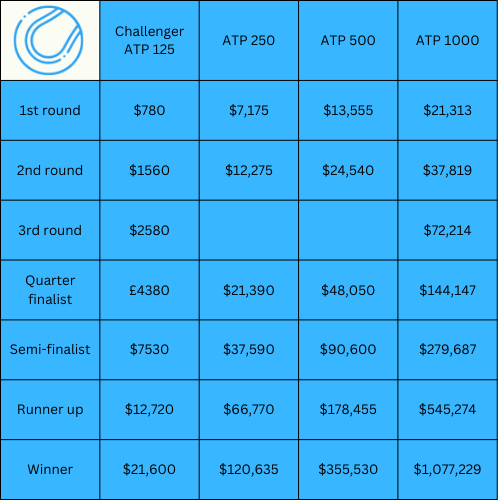
To illustrate the divide between levels, we can see that a winner of a Challenger 125 tournament roughly earns the same prize money as a first-round loser in an ATP 1000 tournament. Of course, you have to be pretty exceptional to be eligible for an ATP 1000 event, having ascended the ranks through ability, and in that respect, tennis can be considered a merit-based hierarchy.
Grand Slam Prize Money
The ultimate ambition for a tennis professional is to win one of the four Grand Slam tournaments. And while most players will say that tennis at this level is about history not prize money, the financial rewards are eye-watering as the below table shows.
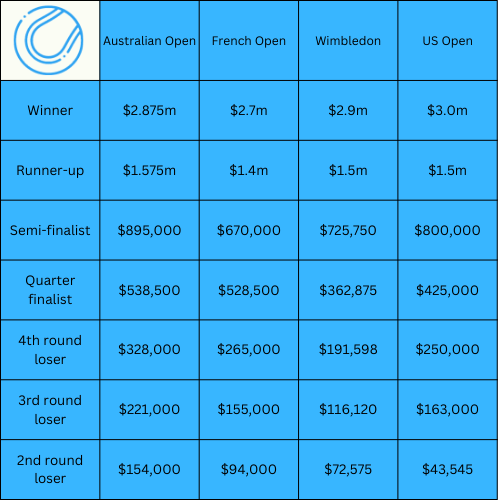
Simply by reaching each of the four slams a player can earn over $250,000 and for many players that alone is a primary objective – to get through qualifying and potentially progress enough to help bankroll future months of travel, hotels, and coaching.
Sponsorship and more: Riches that transcend prize money
For those gifted enough to take home one of the most coveted trophies in tennis, the prize money is mere frosting on what is a very rich cake.
Emma Raducanu is the most recent example of how snagging a slam can transform a player’s profile and indeed bank balance. The young Brit pocketed a cool $2.5m for her 2021 US Open win, but that figure has been eclipsed many times thanks to a queue of blue-chip sponsors eager to capitalize on her success. A list that includes Tiffany, British Airways, Nike, Evian and Porsche.
Additionally, Emma’s sponsors also include Wilson Tennis. She uses their Blade frame and if you are curious about her racket of choice we have a comprehensive resource dedicated to the Blade line.
Raducanu reportedly earns north of $9m each year from her portfolio of sponsors, a figure that dwarfs her 2022 on-court earnings of $697,000. A theme that is best illustrated if we study Roger Federer’s lifetime earnings.
During his career Roger Federer used his Wilson RF97 to earn over $130m earned from prize money alone. However, it is believed that Roger’s ‘total’ lifetime earnings comfortably surpasses $1bn, garnered from endorsement deals, lucrative appearance fees and merchandise sales. Proof indeed, that grand slam success is only the start – a gateway to a world that Futures players can only dream about.
And if this was not enough, the eight most successful players at the season-end (also the year’s highest earners) qualify for the season-ending ATP and WTA Finals tournaments. These limited field events see players from each respective tour battle for prize money totalling $14.7m for the men and $5m for the ladies.
If you still have an appetite for yet more wealth, there are always exhibition matches and bespoke tournaments such as the Laver Cup. It is not uncommon for elite players to command north of $500,000 for personal appearances and for those selected for the Laver Cup, they can pocket between $150,000 and $250,000 depending on the result.
For the majority of players, the struggle is real
Media outlets tend to focus primarily on major tournaments, narrowing the public’s focus exclusively upon the higher echelons of tennis. The reality however, is stark and for every Emma or Roger, there are countless players who routinely lose money in their quest to play professional tennis.
Serving for the Wimbledon title is pressure but playing to merely pay this week’s bills and to travel next week is something else entirely. Expenses (per season) for a traveling professional can range from $40,000 for those on the strictest of budgets, to $200,000 for players electing to take their coach and/or physical trainer on tour. Figures that few lower-tier players can cover without winning consistently.
Recently, BBC Sport interviewed Algerian WTA player Ines Ibbou, who highlighted the struggle faced by players outside of the top 200. A world where prize money fails to cover all expenses and luxuries like free rackets and strings are non-existent. A sobering read that highlights the huge gulf between aspiring pros and the established elite.
Prize Money In Tennis and the Gender Debate
No discussion of prize money in tennis would be complete without considering the topic of gender inequality in tennis – a perennial hot topic.
Both women and men enjoy the same pay scale when it comes to the Grand Slams, albeit that was a protracted process with Wimbledon becoming the last slam to invoke parity in 2007, decades after the US Open adopted this policy in 1973. But beyond the major tournaments, there still exists a significant disparity in prize money between both sexes.
Even though tennis has the lowest gender pay gap of all professional sports, men still earn 34% more prize money on average than their female counterparts. Of course, many argue WTA players consistently play less tennis (a maximum of 3-sets) compared to men who can play a maximum of 5-sets (in Grand Slams only), but nonetheless, it will remain a contentious issue until the gap narrows even further.
Prize money in tennis: The Big Questions
Tennis is fundamentally a business competing for the interest of sports fans in general. Naturally, elite players who generate attention and attract the biggest audiences monopolize the prize money ranks. But nonetheless, it still feels as though the gulf between elite-level players and new professionals is disproportionate – notwithstanding the disparity in prize money between genders.
It would be criminal for a player with genuine talent to leave tennis due to affordability issues, and this is not just the Bros opinion.
Novak Djokovic and fellow pro, Vasek Pospisil, launched a players-only council in 2020 with the remit of giving a voice to and being supportive of, players at all levels. The premise was not a redistribution of wealth, more so the creation of a body that is more aware and supportive of lower-tier tennis – notably to help create sponsorship opportunities for more players.
The Professional Tennis Players Association (PTPA) as it is called was not widely accepted, however. Considered by many to be a breakaway and divisive faction it has yet to receive widespread support, even though its intentions appear credible.
And so the existing dynamic and the same questions remain about an imbalance in the sport and how best to address it. But one thing is true, the rewards for those who make it are life-changing and available to all, providing you have the required tools to reach the summit.
Want more awesome articles on the pro game?
Here are some you might like:
- The Best Tennis Players of All Time (Top 10 Male + Female)
- The Longest Tennis Rallies Ever
- Top 15 Tennis Upsets of All Time
- Why Do Tennis Players Grunt?
Enjoy exploring!
41 Lessons · $49.00
Doubles Tactics
Supercharge Your Doubles With TheTennisBros.com
10 Lessons · $35.00
The Art of Volleying
Become clinical at the net with our in depth volleying walkthroughs!
35 Lessons · $49.00
Singles Tactics
Outsmart your opponent with superior tactics! Our strategies can be quickly implemented for instant results!
We save you time and money by doing the painful research process for you!
No more frustration in your game, due to your equipment failing you!
Start playing the best tennis of your life and win more matches!
Get Our Free Guide to Supercharging Your Tennis Equipment!
Sign up to receive your Free Guide to Supercharging Your Tennis Equipment , straight to your inbox!
Explore more
Dec 12, 2023 • Pro Tennis Professional Setups Tennis Games Tournaments
Tennis Umpires: Who Are They & What Do they Do?
Tennis Umpires: Who Are They, What Do they Do, and How Much Do They Earn? Tennis is like a dance. It's not just about the powerful hits or lightning-fast serves; it's a symphony of precision and anticipation. In the midst of this action, there are unsung heroes—tennis umpires and line…
Sep 28, 2023 • Pro Tennis Tournaments
French Open Prize Money (A Timeline)
In 2022 the French Open men’s and women’s champions walked away with €2.2 million each, with the runner-up pocketing €1.1 million. Not bad for a fortnight’s work! However, with a huge 12.3% increase, 2023 topped the bill with a total pot of €49.6 million. Roland Garros has always had a…
The Tallahassee Tennis Challenger shifts into high gear as top seed falls in opener

The 2024 edition of the Tallahassee Tennis Challenger Presented by Visit Tallahassee shifted into high gear Monday.
Singles qualifying ended with Bogdan Bobrov, Bruno Kuzuhara, Andres Andrade, Corentin Denolly, Gerald Melzer and Victor Lilov advancing to the main draw.
In the first night feature match on Stadium Court, top seed, JJ Wolf found himself in a battle with the 2023 Wimbledon Boy’s Champ, Henry Searle.
Searle, a big soccer fan, fought like he was on the pitch. He saved break points and used his serve and forehand as a weapon to keep Wolf on his heels.
Wolf jumped back to even the second set and forced a tiebreaker, but it was Searle who played the big points the best in taking the 7-5, 7-6 (6) win.
“It gives me a lot of confidence going into the next round,” admitted Searle.
Tallahassee Tennis Challenger Monday results
RESULTS - APRIL 15, 2024
Men's Singles: First Round
H. Searle (GBR) d [1] J. Wolf (USA) 75 76(6)
C. Hemery (FRA) d [3] P. Kypson (USA) 76(2) 63
H. Habib (LIB) d [4] D. Kudla (USA) 76(6) 64
J. Schwaerzler (AUT) d G. Fonio (ITA) 62 64
[WC] S. Kozlov (USA) d G. Campana Lee (KOR) 46 63 60
Men's Qualifying Singles: Second Round
Qualifying - [2] B. Bobrov d [8] S. Kirchheimer (USA) 46 63 63
Qualifying - [3] C. Denolly (FRA) d [WC] I. Mayew (USA) 76(4) 63
Qualifying - [11] G. Melzer (AUT) d [4] K. Edmund (GBR) 26 60 63
Qualifying - [6] B. Kuzuhara (USA) d [10] A. Rybakov (USA) 76(3) 63
Qualifying - [7] A. Andrade (ECU) d T. McCormick (USA) 46 61 64
Qualifying - [12] V. Lilov (USA) d A. Rai (NZL) 76(5) 16 62
ORDER OF PLAY: TUESDAY, APRIL 16, 2024
STADIUM start 11 am
T. Sandgren (USA) vs [6] M. Damm (USA)
M. Krueger (USA) vs E. Quinn (USA)
[WC] K. Bigun (USA) vs [Q] B. Bobrov
Not Before 6:00 pm
Alternate vs [WC] E. Jose Ribeiro Lago (ITA) / D. Vale (POR)
T. Kodat (USA) vs [2] Z. Bergs (BEL)
COURT 1 start 11:00 am
O. Crawford (GBR) vs D. Popko (KAZ)
[Q] A. Andrade (ECU) vs F. Gomez (ARG)
T. Kwiatkowski (USA) vs [8] T. Boyer (USA)
[Q] G. Melzer (AUT) vs [LL] K. Edmund (GBR)
COURT 5 start 11:00 am
[WC] D. Vale (POR) vs [Q] C. Denolly (FRA)
C. Tabur (FRA) vs [Q] V. Lilov (USA)
[7] A. Ritschard (SUI) vs [Q] B. Kuzuhara (USA)
M. Damm (USA) / A. Rybakov (USA) vs [4] T. Fancutt (AUS) / H. Reese (USA)
Singles Main Draw – Monday, April 15
Doubles Main Draw – Tuesday, April 16
Proceeds from the tournament continue to benefit the Vogter Neuro-ICU. In 2019 the new state of the art Vogter Neuro Intensive Care Unit opened in the Mustian Surgery Center of Tallahassee Memorial HealthCare. This unit cares for patients of all ages who suffer neurological trauma (such as head injuries, strokes), require surgical intervention for life-threatening illnesses (brain tumors, aneurysms), and many other types of patients too numerous to name. Over the past 25 years funds have been contributed from the tournament and last year the D. Mark Vogter Memorial Endowment reached $1,100,000 in the corpus of the endowment.
A new fund was created in 2010—the Maria Yealdhall Challenger Tennis Fund was established with the Tallahassee Friends of Our Parks Foundation, the fund-raising arm of the Parks, Recreation and Neighborhood Affairs Department. All monies collected from ticket sales are donated to this endowment each year and are used to assist in tennis related projects and programs throughout the city. Shade structures at Winthrop Park and at Tom Brown Park as well as several awnings at Forestmeadows are some of the improvements made with these funds.
A tournament of this size could not happen without committed volunteers who work every year. From ball kids/babes & dudes, who stand on the court for hours, to the food-Moms and hostesses, drivers, desk volunteers and organizers, thousands of hours are donated to make this tournament run smoothly. If you are interested in becoming a volunteer before, during or immediately following the tournament please contact Karen Vogter, Tournament Director, at [email protected]
Forestmeadows Tennis Complex
The Department of Parks, Recreation and Neighborhood Affairs operates many community centers throughout the City. Each of these offers a wide array of daily activities for youth and adults, from athletics to homework to cooking.
4750 North Meridian Road, Tallahassee, FL 32312
Phone: 850-891-4979
About the ATP Challenger Tour
It all starts here. The ATP Challenger Tour is the launchpad of men's professional tennis, featuring more than 180 tournaments across more than 40 countries. At this level, players develop their skills and earn valuable experience against strong competition, while fighting for critical points and prize money, all with the collective goal of progressing onto the ATP Tour. Since it was founded in 1978, the ATP Challenger Tour has been an intense battleground on a global stage, providing fans the opportunity to witness worldclass tennis and follow the journeys of the stars of tomorrow as they launch their professional careers. Live stream the action throughout the year via Challenger TV on www.ATPTour.com .
WHAT IS THE ATP CHALLENGER TOUR?
The ATP Challenger Tour is the second-highest level of men's professional tennis in the world. Since its inception in 1978, competition on the tour has been intense, with players fighting for critical PIF ATP Rankings points and prize money. These tournaments (196 events in 46 countries) give fans the excitement of watching world class tennis in a smaller, more intimate setting.
The purpose of the ATP Challenger Tour is to provide opportunities for players to develop their talents and skills from a young age, while gaining valuable experience against strong competition. The circuit has been the first step for the sport’s most accomplished stars, including Novak Djokovic, Roger Federer and Rafael Nadal. Regardless of talent and potential, every player must work their way up the PIF ATP Rankings, as they strive to reach the Top 100 and compete on the ATP Tour and in Grand Slam tournaments.
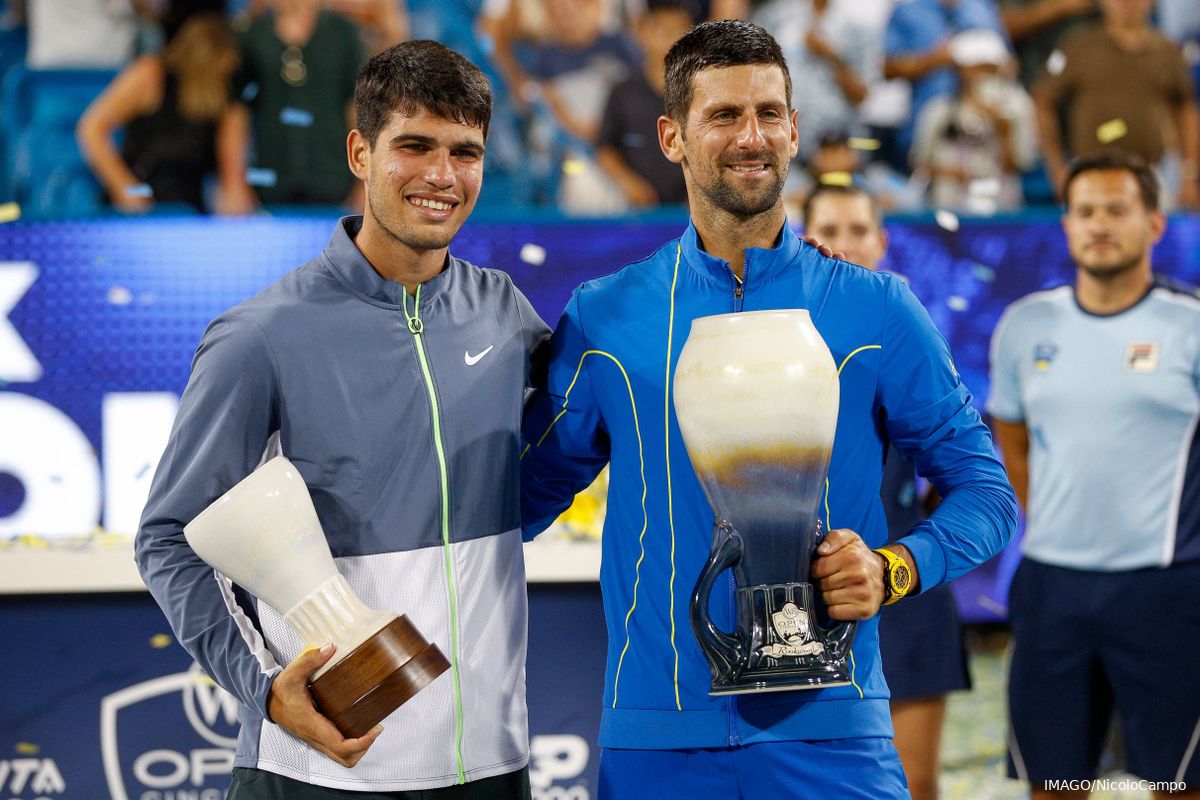
ATP Confirms Changes To Ranking Points Breakdown In Tour-Level Tournaments From 2024

by Nurein Ahmed
28/12/2023 00:30
The ATP has issued an updated ranking system, which will largely affect the points breakdown of tour-level tournaments beginning from the 2024 season.
The ATP plays a significant role in determining player rankings on the men's tour by allocating ranking points. Players compete not just for prize money but for points, which are awarded based on the round reached and the tournament's level.
In a press release on Tuesday, the men's tennis governing body announced a revamp in the points breakdown solely impacting singles draws for tournaments. The doubles draws will remain the same as they were last season.
The overriding factor that brought about these changes is to enable lower-ranked players who don't make it to the deep end of tournaments to accumulate more ranking points than in previous seasons.
ATP Announces Significant Reforms To Next Gen Brand Beginning From 2024
In its statement, the ATP noted that the changes were designed to optimize the points distribution following the expansion of several Masters 1000 draws to 96 players while also "delivering an improved balance and distribution of points" due to increased high-level ATP Challenger tournaments.
For instance, all Grand Slams and ATP Tour events will see increased rankings points. Those who win a major will not be affected as they will still collect the full 2000 ranking points, but finishing a runner-up in a Slam results in an additional 100 points, taking the final tally to 1,300.
At the Grand Slam level, these changes will be reflected from the second round until the final (runner-up). The same theme will be replicated at the Masters 1000 level (except for the 56-player draw), which will see a marginal increase, with the runner-up set to receive an additional 50 points from last season.
For the 56-player draw, ranking changes will happen from the third round until the final. The champion will still collect 1000 ranking points, but the runner-up will receive 650 points instead of 600 from 2023.
The ATP 500 and ATP 250 are considered the lowest levels of the Tour-level ladder, and as such, those tournament categories will see small increases not exceeding 30 points. The complete breakdown can be accessed down below.

'Unbelievable' Nadal Backed For Phoenix-Like Comeback Despite 'Everyone Writing Him Off'
Gauff in pole position to become new world no. 2 after madrid open.
Wednesday, 24 April 2024
Kenin Extends Losing Streak To 9 Matches With Another Disappointing Loss In Madrid
Tuesday, 23 April 2024
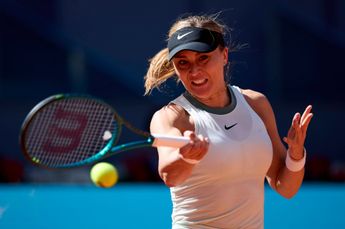
Badosa Shocked In Opening Round Of Home Tournament In Madrid Wednesday, 24 April 2024

Alcaraz Would 'Prefer One More Day' Of Recovery Amid Race Against Time To Play In Madrid Tuesday, 23 April 2024

Kokkinakis Eliminates Thiem In Last Round Of Qualifying To Secure Madrid Open Main Draw Tuesday, 23 April 2024
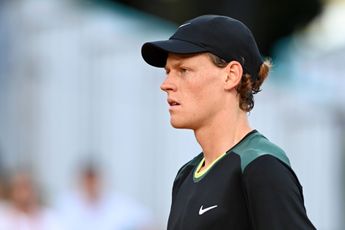
Sinner 'Completely Got Over' Missed Crucial Call In Monte Carlo Loss To Tsitsipas Wednesday, 24 April 2024

'Don't Want My Name To Be Erased': Osaka Targets 'Making History' In Tennis Wednesday, 24 April 2024
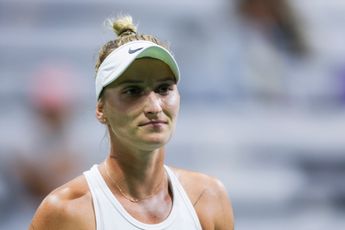
Wimbledon Champion Vondrousova Announces Divorce From Her Husband Wednesday, 24 April 2024
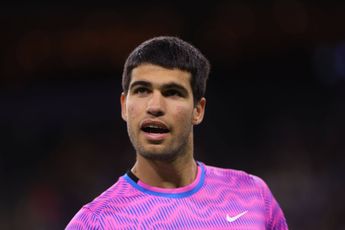
Alcaraz Honestly Assesses His Chances Of Competing In Madrid Amid Injury Fears Wednesday, 24 April 2024
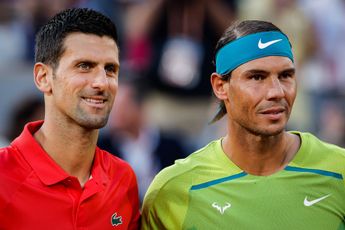
Djokovic 'Hopes To Play' Nadal 'At Least One More Time Before He Retires' Tuesday, 23 April 2024
You may also like.
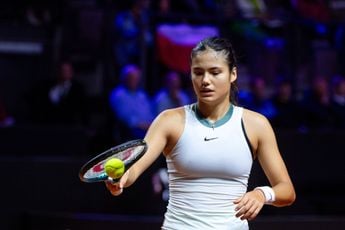
Raducanu Admits To Concealing Surgery Plans In Infamous 58-Word Madrid Press Conference
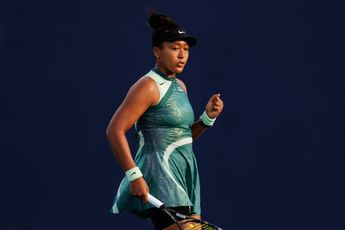
Osaka Records Her First Clay Win Since 2022 With Impressive First-Round Showing In Madrid
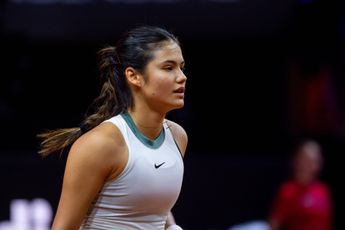
Raducanu Told 'She Doesn't Need To' Play Every Week Despite Recent Success
Badosa shocked in opening round of home tournament in madrid.
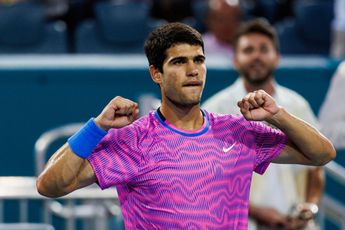
Alcaraz 'Starting To See Light' After Prolonged Injury Struggles Says Coach

IMAGES
COMMENTS
The ATP Challenger Tour, known until the end of 2008 as the ATP Challenger Series, is a series of international men's professional tennis tournaments. ... Players who succeed on the ATP Challenger Tour earn sufficient ranking points to become eligible for main draw or qualifying draw entry at ATP Tour tournaments. Players on the Challenger Tour ...
ATP Challenger Tour, the stepping stone to the ATP Tour. Free live streaming, live scores, results, draws, exclusive interviews.
A player's ATP ranking is based on the total points he accrued in the following 20 tournaments (19 if he did not qualify for the ATP Finals): ... the points breakdown was adjusted to award more points in ATP Tour events. ... ATP Challenger Tour: Challenger 175: 175: 90: 50: 25: 13: 6 Challenger 125: 125: 64: 35: 16: 8: 5 Challenger 100 100: 50 ...
Winners on both ATP Tour & ATP Challenger Tour (0) Player ATP Tour title ATP Challenger Tour title Longest Finals (Games) Lugano, SUI Otto Virtanen d. Daniel Masur 67(4) 64 76(3) - 36 games Longest Final (Time) Asuncion, PAR Gustavo Heide d. Joao Fonseca 75 67(6) 61 - 3 hours, 15 minutes Shortest Completed Final (Games)
Live ATP Ranking. Live Ranking: Race: Tournament Draws: Schedule: Live Scores: Live ATP Ranking #: Tennis Player Rank CH: Career High NCH ... ATP250, CH175/125/100/75/50, M25/15 (GS/ATP Tour/Challengers/ITF + winner points) ...
The ATP Challenger 125 tournaments are the second highest tier of annual men's tennis tournaments on the ATP Challenger Tour, with 125 ranking points awarded to each singles champion.They were previously the highest tier of Challenger tournaments before the introduction of ATP Challenger Tour 175 tournaments in 2023.. As of the last full season in 2019, the series included 20 tournaments ...
ATP Tour & Challenger Tour Winners Borna Coric and Holger Rune showed their dominance at the Challenger level and on the ATP Tour in 2022.. Coric, who won the Parma Challenger in June, upset three Top-10 players en route to winning the title in Cincinnati to become the first player since 1993 to win a Challenger and an ATP Masters 1000 title in the same season.
After you earn enough points at playing futures, you can graduate to the ATP Challenger Tour. The Challengers are the lowest level tournaments hosted by the ATP. There are 5 tiers of challengers: ATP Challenger Tour 80, 90, 100, 110 and 125. Here is the points breakdown:
Tour and the ATP Challenger Tour. The ATP determines the rules for ATP tournaments and determines the points allocation for all men's professional events. In 2019, prior to 5 August, ATP Rankings are based on a player's performance at Grand Slams, ATP Tour and Challenger tournaments and the later rounds of $25,000 ITF tournaments.
A player's ranking is based off their best 18 tournaments, but players should read the rules on how the rankings are calculated in the ATP Tour Rulebook. Prior. Please see table below. ATP Ranking Points Table . ATP 1000 . ITF World Tennis Tour . Updates . Players should always check for the most current ATP rules information in the ATP ...
More about the ATP Tennis Ranking Points. ATP FINALS - 200pts for every win the round robin, additional 400pts for winning the semifinal, and additional 500pts for winning the final. ATP1000 - Qualifying points change to 16 points only if the main draw is larger than 56.. ATP500 - Qualifying points change to 10 points only if the main draw is larger than 32
Seven 'Best Other' (ATP Cup, ATP Masters 1000 Monte Carlo, ATP 500, ATP 250, Challenger, ITF) ... Teams receiving a first round bye and subsequently losing in the final round receive no points *** ATP Doubles Ranking points will be awarded in the ITF M/25M+H and ITF M15/15+H tournaments beginning with the quarter final. ... 2024 ATP Tour ...
Defunct tiers (1970-2008) Grand Prix Super Series. International Series Gold. International Series. ATP Cup. v. t. e. The ATP Challenger 175 tournaments are the highest tier of annual men's tennis tournaments on the ATP Challenger Tour, with 175 ranking points awarded to each singles champion.
Up-to-date ATP & WTA Rankings: ATP TOP 10 - ATP TOP 100. WTA Ranking points system. WTA adopted the new system of categories at the start of the 2021 season. It adopts a similar system to the one used by the ATP tour. There are four categories of WTA tournaments [Grand Slams*, WTA 1000, WTA 500, WTA 250] and one lower-tier WTA 125 tournament.
By contrast, the winner of an ATP Tour event can earn upwards of 1,000 ranking points and a prize purse of more than $1 million. However in 2023 the ATP launched a new tier of Challengers known as Challenger 175s in which, as the name suggests, the winner can earn 175 points along with prize money of $220,000.
In 2021, ATP Challenger Tour players competed for prize money ranging from $36,680 to $156,240 per tournament, whereas their WTA counterparts contested similar purses. ... The winner of an ATP 125 event garners 125 ATP ranking points. Naturally, prize money tends to increase in correlation with the ranking points on offer. ...
About the ATP Challenger Tour. ... Since its inception in 1978, competition on the tour has been intense, with players fighting for critical PIF ATP Rankings points and prize money. These ...
The ATP Challenger Tour in 2021 was the secondary professional tennis circuit organized by the ATP. The 2021 ATP Challenger Tour calendar comprised 147 tournaments with prize money ranging from $36,680 up to $156,240. It was the 44th edition of challenger tournaments cycle, and 13th under the name of Challenger Tour. Tallon Griekspoor set a new record for winning the most Challenger titles in ...
Four of the five ATP Challenger Tour champions Sunday celebrated milestone moments with their title runs, including Argentine Francisco Comesana, who made his Top 100 debut in the PIF ATP Rankings after winning the Oeiras Open 3.. Giovanni Mpetshi Perricard lifted back-to-back trophies in Mexico, Belgian Zizou Bergs successfully defended his title in Tallahassee, Florida, and former World No ...
28/12/2023 00:30. 69. The ATP has issued an updated ranking system, which will largely affect the points breakdown of tour-level tournaments beginning from the 2024 season. The ATP plays a significant role in determining player rankings on the men's tour by allocating ranking points. Players compete not just for prize money but for points ...
IX. ATP RANKINGS Tour Masters 1000 tournaments and the Nitto ATP Finals of the ranking period, the ATP Cup and his best seven (7) results from all ATP Tour 500, ATP Tour 250, ATP Challenger Tour and ITF Men's WTT tournaments. For every Grand Slam or manda-tory ATP Tour Masters 1000 tournament for which a player is not in the main draw,
La saison 2024 de l'ATP Challenger Tour, ... Les tournois distribuent des points pour le classement ATP. Points distribués en 2024 Catégorie du tournoi V F DF QF T2 T1 Q Q2 Q1; ATP Challenger 175 175 90 50 25 13 0 6 3 0 ATP Challenger 125 125 64 35 16 8 0 5 3 0 ATP Challenger 100
Official PIF ATP Rankings (Singles) showing a list of top players in men's tennis rankings on the ATP Tour, featuring Novak Djokovic, Rafael Nadal, Jannik Sinner, Carlos Alcaraz and more.
The results of ITF tournaments are incorporated into the ATP ranking, which enables professionals to progress to the ATP Challenger Tour and ATP Tour, and ultimately the Grand Slams. The offers approximately 550 tournaments across 70 countries. ... ↓ ATP Ranking Points ↓ M25+H (S) / M25 (S) ...
Grass Season Kicks Into High Gear In Nottingham The pristine grass courts of the Nottingham Tennis Centre host the Rothesay Open, a prestigious Challenger 125-level event on the ATP Challenger Tour. Notable winners include Steve Johnson, who lifted the trophy in 2013, followed by Nick Kyrgios a year later. The venue previously hosted an ATP ...
The Association of Tennis Professionals (ATP) Challenger Tour in 2023 was the secondary professional tennis circuit organized by the ATP. The 2023 ATP Challenger Tour calendar comprised 196 tournaments, with prize money ranging from $40,000 up to $220,000. It was the 46th edition of Challenger tournaments cycle and 15th under the name of Challenger Tour.